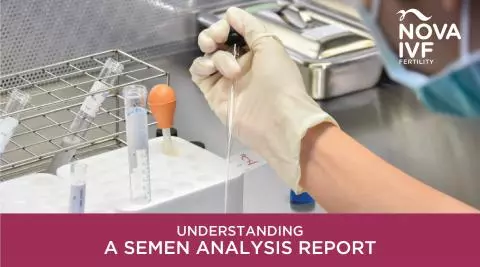What is the Testicular Sperm Aspiration (TESA) Procedure?
TESA is an advanced technique for extracting sperm from the testicles to be used in IVF fertilisation or microinjection.
Typically, it is conducted under local anaesthesia and in conjunction with the extraction of the female partner's eggs. A fine needle is directed into the testicle to extract sperm.
TESA is preferred in males suffering from a vasectomy, obstructive azoospermia, or any other functional issues. When TESA fails to extract enough sperm, then an open testicular biopsy is often required.
Once the doctor has collected the sperm using TESA, it can be used for in vitro fertilisation (IVF) right away, or the sperm may be preserved for later use. This is called cryopreservation of sperm. The fertility specialist can guide you on the best approach.
When is the TESA Procedure Recommended?
TESA is performed when conception is the goal; however, it is not attainable without assistance. It is intended for males who have no or little sperm in their semen or who are unable to ejaculate. In such circumstances, sperm can be obtained from various parts of the male reproductive canal, such as from the testicles, in a procedure called testicular sperm aspiration (TESA). TESA is recommended for males suffering from:
Obstructive Azoospermia:
- Impaired release of sperm caused by injury
- Azoospermia (total absence of sperm)
- Blockage of the seminal duct following urethral surgery or catheterisation
- Ejaculation issues, for instance, retrograde ejaculation.
- vasectomy (seminal duct ligation)
- Congenitally missing vas deferens
- Venereal infections, for example, Chlamydia-gonorrhoea
- bladder or Prostate surgery
Non-Obstructive Azoospermia:
- Cancer therapy, such as radiotherapy or chemotherapy
- Genetic disorders impacting fertility
- Unilateral orchiectomy
- Surgical treatment for undescended testicles.
Sperm retrieval through TESA is combined with IVF and ICSI to achieve good rates of pregnancy.
How is TESA Performed?
The TESA procedure is typically a minimally invasive technique and is performed at the specialist's clinic. Generally, there is no need to prepare for a TESA procedure; however, it is best to talk to the specialist regarding your specific case.
- On the day of the procedure, the specialist first administers a sedative and applies local anaesthesia to temporarily numb the testicle along with the region around it.
- Next, a fine needle is inserted into the testicle, and the sperm are aspirated using a syringe.
- This sample is then sent to the laboratory for extracting heathy sperm to be used for IVF or ICSI.
- The entire procedure takes about 30 minutes.
Post-Procedure Care
After TESA, you will not have any cuts or sutures in the testicles or scrotum. However, you shouldn't do heavy lifting or intense physical activity for approximately a week and wait a couple of days before engaging in sex or masturbation.
Antibiotics may also be prescribed following TESA to reduce the chance of infection.
In most cases, a follow-up consultation with your doctor is not required.
Is it painful to undergo the TESA procedure?
You would experience pain if you were not given anaesthesia. However, the local anaesthetic (numbing) and sedative provided by the specialist will keep you comfortable throughout the procedure. If you experience pain following TESA, over-the-counter pain medications like ibuprofen or acetaminophen can help. Wearing supportive undergarments or a jock strap may help as well.
Potential Risks and Complications of TESA Procedure
Although complications from TESA are not common, the potential issues may include:
- Infection, bleeding, and pain.
- Likelihood of failing to find sperm
- Requirement for additional procedures
- Injury to the testicle
- Testicular loss (rare)
If you notice any of the above-mentioned signs and symptoms, it is recommended that you contact your doctor right away.
Success Rates and Outcomes of TESA
When performing a TESA procedure, surgeons can almost always obtain sperm; however, the success rate may vary based on other factors, including the underlying reason for infertility, the man's age, and his health in general.
If your surgeon is unable to obtain sperm with the TESA procedure, another sperm collection method may be used.
Microsurgical testicular sperm extraction (microTESE) and Testicular sperm extraction (TESE) are two other sperm retrieval techniques.
Even though viable sperm is obtained through TESA, the fact that IVF will be successful is not a guarantee. The success of IVF depends on the female partner’s associated factors as well.
Takeaway
TESA is an advanced surgical procedure for men experiencing male infertility due to sperm issues, providing a chance for becoming parents. Its minimally invasive nature, in addition to the potential for successful sperm retrieval, makes it a crucial option in the ARTs. With minimal risk considerations, the advantages often surpass the disadvantages, particularly for couples dealing with the difficulties of infertility.
FAQs About Testicular Sperm Aspiration
What is TESA?
Testicular sperm aspiration (TESA) is one of the methods of sperm retrieval in male factor infertility. In this procedure, a fine needle is used to extract sperm from the testicles.
Are there any other procedures for sperm retrieval apart from TESA?
Yes, there are several other techniques, depending on the problem, that can be used for sperm retrieval. Some of them are:
- Microscopic testicular sperm extraction (micro-TESE)
- Microsurgical Epididymal Sperm Aspiration (MESA)
- Percutaneous epididymal sperm aspiration (PESA)
- Testicular sperm extraction (TESE)
How does TESA function and benefit?
Male infertility is one of the major concerns for numerous couples. Infertility can be caused by a variety of factors, including the quantity and quality of sperm in men, as well as an inability to ejaculate. In such circumstances, TESA is an established procedure option for male infertility that can help couples start a family.
Who is recommended for TESA?
- TESA is often recommended for males:
- Diagnosed with azoospermia (obstructive and non-obstructive)
- With no sperm in the ejaculate
- Previously, sperm retrieval procedures, such as PESA, were unsuccessful.
 Infertility Counselling
Infertility Counselling Female Infertility Treatment
Female Infertility Treatment Andrology Treatment
Andrology Treatment Fertility Enhancing Surgeries - Female
Fertility Enhancing Surgeries - Female Fertility Enhancing Surgeries - Male
Fertility Enhancing Surgeries - Male Endoscopy Treatment
Endoscopy Treatment IUI Treatment
IUI Treatment IVF Treatment
IVF Treatment ICSI Treatment
ICSI Treatment Advanced IVF Solutions
Advanced IVF Solutions Embryology
Embryology Vitrification Egg, Embryo, Sperm Freezing
Vitrification Egg, Embryo, Sperm Freezing Preimplantation Genetic Testing (PGT)
Preimplantation Genetic Testing (PGT) Donation Program Embryo / Egg / Sperm
Donation Program Embryo / Egg / Sperm Self-cycleTM IVF
Self-cycleTM IVF

 Self-cycleTM IVF
Self-cycleTM IVF











